
The Union Jack or Union Flag is the de facto national flag of the United Kingdom. The Union Flag was also used as the official flag of several British colonies and dominions before they adopted their own national flags. The flag continues to have official status in Canada, by parliamentary resolution, where it is known as the Royal Union Flag.

East Lothian is one of the 32 council areas of Scotland, as well as a historic county, registration county and lieutenancy area. The county was called Haddingtonshire until 1921.
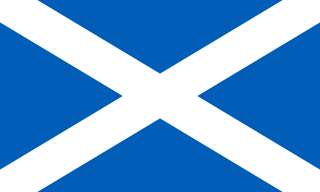
The flag of Scotland is the national flag of Scotland, which consists of a white saltire defacing a blue field. The Saltire, rather than the Royal Standard of Scotland, is the correct flag for all private individuals and corporate bodies to fly. It is also, where possible, flown from Scottish Government buildings every day from 8:00 am until sunset, with certain exceptions.

A saltire, also called Saint Andrew's Cross or the crux decussata, is a heraldic symbol in the form of a diagonal cross. The word comes from the Middle French sautoir, Medieval Latin saltatoria ("stirrup").

The coat of arms of Nova Scotia is the heraldic symbol representing the Canadian province of Nova Scotia. It is the oldest provincial achievement of arms in Canada, and the oldest British coat of arms in use outside Great Britain. It is blazoned as follows: Argent, a saltire azure charged with an escutcheon of the Royal Arms of Scotland.

Three Crowns is the national emblem of Sweden, present in the coat of arms of Sweden, and composed of three yellow or gilded coronets ordered two above and one below, placed on a blue background. Similar designs are found on a number of other coats of arms or flags.

The national flag of Spain, as it is defined in the Constitution of 1978, consists of three horizontal stripes: red, yellow and red, the yellow stripe being twice the height of each red stripe. Traditionally, the middle stripe was defined by the more archaic term of gualda, and hence the popular name la Rojigualda (red-weld).

The flag of Great Britain, often referred to as the King's Colour, first Union Flag, Union Jack, and British flag, was used at sea from 1606 and more generally from 1707 to 1801. It was the first flag of the Kingdom of Great Britain. It is the precursor to the Union Jack of 1801.
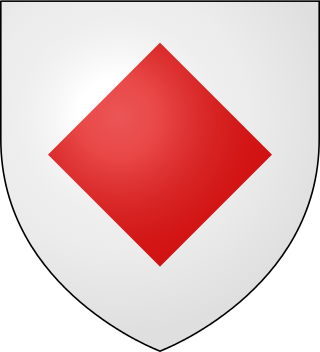
The lozenge in heraldry is a diamond-shaped rhombus charge, usually somewhat narrower than it is tall. It is to be distinguished in modern heraldry from the fusil, which is like the lozenge but narrower, though the distinction has not always been as fine and is not always observed even today. A mascle is a voided lozenge—that is, a lozenge with a lozenge-shaped hole in the middle—and the rarer rustre is a lozenge containing a circular hole in the centre. A lozenge throughout has "four corners touching the border of the escutcheon". A field covered in a pattern of lozenges is described as lozengy; similar fields of mascles are masculy, and fusils, fusily. In civic heraldry, a lozenge sable is often used in coal-mining communities to represent a lump of coal.
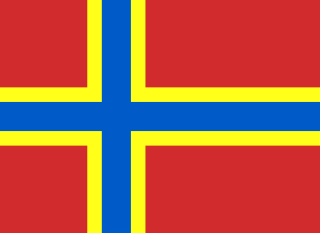
The Flag of Orkney was the winner of a public flag consultation in February and March 2007. In the flag consultation the people of Orkney were asked for their preferred design from a short list of 5, all of which had been approved by the Court of the Lord Lyon. The chosen design was that of Duncan Tullock of Birsay, which polled 53% of the 200 votes cast by the public.
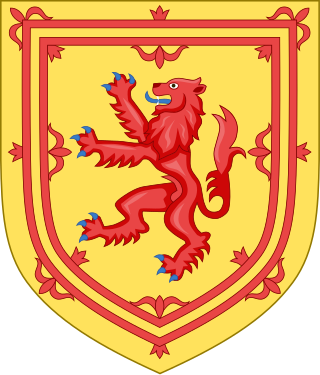
The coat of arms of Scotland, colloquially called the Lion Rampant, is the coat of arms historically used as arms of dominion by the monarchs of the Kingdom of Scotland, and later used within the coat of arms of Great Britain and the present coat of arms of the United Kingdom. The arms consist of a red lion surrounded by a red double border decorated with fleurs-de-lis, all on a gold background. The blazon, or heraldic description, is: Or a lion rampant Gules armed and langued Azure within a double tressure flory-counter-flory of the second.

The Royal Banner of the Royal Arms of Scotland, also known as the Royal Banner of Scotland, or more commonly the Lion Rampant of Scotland, and historically as the Royal Standard of Scotland, or Banner of the King of Scots, is the royal banner of Scotland, and historically, the royal standard of the Kingdom of Scotland. Used historically by the Scottish monarchs, the banner differs from Scotland's national flag, the Saltire, in that its official use is restricted by an Act of the Parliament of Scotland to only a few Great Officers of State who officially represent the Monarchy in Scotland. It is also used in an official capacity at royal residences in Scotland when the Head of State is not present.

The Saint Alban's Cross is a yellow saltire on a blue field. It is found in several flags, notably that of the Cathedral and Abbey Church of St Alban, previously a Benedictine monastery, and the city of St Albans, Hertfordshire.

Saint Patrick's Saltire or Saint Patrick's Cross is a red saltire on a white field. In heraldic language, it may be blazoned argent, a saltire gules. Saint Patrick's Flag is a flag composed of Saint Patrick's Saltire. The origin of the saltire is disputed. Its association with Saint Patrick dates from the 1780s, when the Anglo-Irish Order of Saint Patrick adopted it as an emblem. This was a British chivalric order established in 1783 by George III. It has been suggested that it derives from the arms of the powerful Geraldine or FitzGerald dynasty. Some Irish nationalists and others reject its use to represent Ireland as a "British invention" "for a people who had never used it".
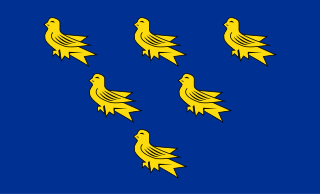
The Flag of Sussex is the flag of the traditional and historic county of Sussex. The flag was registered by the Flag Institute on Friday 20 May 2011 as a 'traditional' county flag as a result of a campaign started in August 2010, by Sussex resident Brady Ells, with support from his father, David. The Flag was certified by Chief Vexillologist, Graham Bartram. It was first flown officially on Saturday 28 May 2011 at Lewes Castle. and was flown from the Department of Communities and Local Government at Eland House, London on Sussex Day, 16 June 2011.

The Flag of County Durham is the flag of the historic county of Durham. It was registered with the Flag Institute as the flag of the county in 2013, after winning an online competition to decide a flag for the county.

The Caithness flag is the flag of the county of Caithness. It was registered with the Flag Institute as the official flag of the county in 2016. The flag was unveiled by the Lord Lyon, Dr Joseph Morrow, at a ceremony in Caithness House, Wick on 26 January 2016. The Nordic cross design symbolises the ancient ties of the county to the Vikings. The black recalls the county's geology with the famous Caithness flagstone, while the gold and blue allude to the beaches and sea reinforcing the maritime nature of the county and its heritage. The traditional emblem of Caithness, a galley, is placed in the first quarter, with a raven upon its sail as it appears in the county's civic arms.





















